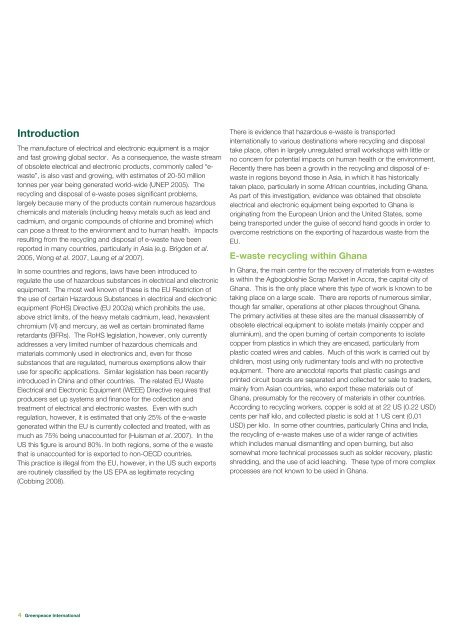Chemical contamination at e-waste recycling and ... - Greenpeace
Chemical contamination at e-waste recycling and ... - Greenpeace
Chemical contamination at e-waste recycling and ... - Greenpeace
You also want an ePaper? Increase the reach of your titles
YUMPU automatically turns print PDFs into web optimized ePapers that Google loves.
Introduction<br />
The manufacture of electrical <strong>and</strong> electronic equipment is a major<br />
<strong>and</strong> fast growing global sector. As a consequence, the <strong>waste</strong> stream<br />
of obsolete electrical <strong>and</strong> electronic products, commonly called “e<strong>waste</strong>”,<br />
is also vast <strong>and</strong> growing, with estim<strong>at</strong>es of 20-50 million<br />
tonnes per year being gener<strong>at</strong>ed world-wide (UNEP 2005). The<br />
<strong>recycling</strong> <strong>and</strong> disposal of e-<strong>waste</strong> poses significant problems,<br />
largely because many of the products contain numerous hazardous<br />
chemicals <strong>and</strong> m<strong>at</strong>erials (including heavy metals such as lead <strong>and</strong><br />
cadmium, <strong>and</strong> organic compounds of chlorine <strong>and</strong> bromine) which<br />
can pose a thre<strong>at</strong> to the environment <strong>and</strong> to human health. Impacts<br />
resulting from the <strong>recycling</strong> <strong>and</strong> disposal of e-<strong>waste</strong> have been<br />
reported in many countries, particularly in Asia (e.g. Brigden et al.<br />
2005, Wong et al. 2007, Leung et al 2007).<br />
In some countries <strong>and</strong> regions, laws have been introduced to<br />
regul<strong>at</strong>e the use of hazardous substances in electrical <strong>and</strong> electronic<br />
equipment. The most well known of these is the EU Restriction of<br />
the use of certain Hazardous Substances in electrical <strong>and</strong> electronic<br />
equipment (RoHS) Directive (EU 2002a) which prohibits the use,<br />
above strict limits, of the heavy metals cadmium, lead, hexavalent<br />
chromium (VI) <strong>and</strong> mercury, as well as certain bromin<strong>at</strong>ed flame<br />
retardants (BFRs). The RoHS legisl<strong>at</strong>ion, however, only currently<br />
addresses a very limited number of hazardous chemicals <strong>and</strong><br />
m<strong>at</strong>erials commonly used in electronics <strong>and</strong>, even for those<br />
substances th<strong>at</strong> are regul<strong>at</strong>ed, numerous exemptions allow their<br />
use for specific applic<strong>at</strong>ions. Similar legisl<strong>at</strong>ion has been recently<br />
introduced in China <strong>and</strong> other countries. The rel<strong>at</strong>ed EU Waste<br />
Electrical <strong>and</strong> Electronic Equipment (WEEE) Directive requires th<strong>at</strong><br />
producers set up systems <strong>and</strong> finance for the collection <strong>and</strong><br />
tre<strong>at</strong>ment of electrical <strong>and</strong> electronic <strong>waste</strong>s. Even with such<br />
regul<strong>at</strong>ion, however, it is estim<strong>at</strong>ed th<strong>at</strong> only 25% of the e-<strong>waste</strong><br />
gener<strong>at</strong>ed within the EU is currently collected <strong>and</strong> tre<strong>at</strong>ed, with as<br />
much as 75% being unaccounted for (Huisman et al. 2007). In the<br />
US this figure is around 80%. In both regions, some of the e <strong>waste</strong><br />
th<strong>at</strong> is unaccounted for is exported to non-OECD countries.<br />
This practice is illegal from the EU, however, in the US such exports<br />
are routinely classified by the US EPA as legitim<strong>at</strong>e <strong>recycling</strong><br />
(Cobbing 2008).<br />
There is evidence th<strong>at</strong> hazardous e-<strong>waste</strong> is transported<br />
intern<strong>at</strong>ionally to various destin<strong>at</strong>ions where <strong>recycling</strong> <strong>and</strong> disposal<br />
take place, often in largely unregul<strong>at</strong>ed small workshops with little or<br />
no concern for potential impacts on human health or the environment.<br />
Recently there has been a growth in the <strong>recycling</strong> <strong>and</strong> disposal of e-<br />
<strong>waste</strong> in regions beyond those in Asia, in which it has historically<br />
taken place, particularly in some African countries, including Ghana.<br />
As part of this investig<strong>at</strong>ion, evidence was obtained th<strong>at</strong> obsolete<br />
electrical <strong>and</strong> electronic equipment being exported to Ghana is<br />
origin<strong>at</strong>ing from the European Union <strong>and</strong> the United St<strong>at</strong>es, some<br />
being transported under the guise of second h<strong>and</strong> goods in order to<br />
overcome restrictions on the exporting of hazardous <strong>waste</strong> from the<br />
EU.<br />
E-<strong>waste</strong> <strong>recycling</strong> within Ghana<br />
In Ghana, the main centre for the recovery of m<strong>at</strong>erials from e-<strong>waste</strong>s<br />
is within the Agbogbloshie Scrap Market in Accra, the capital city of<br />
Ghana. This is the only place where this type of work is known to be<br />
taking place on a large scale. There are reports of numerous similar,<br />
though far smaller, oper<strong>at</strong>ions <strong>at</strong> other places throughout Ghana.<br />
The primary activities <strong>at</strong> these sites are the manual disassembly of<br />
obsolete electrical equipment to isol<strong>at</strong>e metals (mainly copper <strong>and</strong><br />
aluminium), <strong>and</strong> the open burning of certain components to isol<strong>at</strong>e<br />
copper from plastics in which they are encased, particularly from<br />
plastic co<strong>at</strong>ed wires <strong>and</strong> cables. Much of this work is carried out by<br />
children, most using only rudimentary tools <strong>and</strong> with no protective<br />
equipment. There are anecdotal reports th<strong>at</strong> plastic casings <strong>and</strong><br />
printed circuit boards are separ<strong>at</strong>ed <strong>and</strong> collected for sale to traders,<br />
mainly from Asian countries, who export these m<strong>at</strong>erials out of<br />
Ghana, presumably for the recovery of m<strong>at</strong>erials in other countries.<br />
According to <strong>recycling</strong> workers, copper is sold <strong>at</strong> <strong>at</strong> 22 US (0.22 USD)<br />
cents per half kilo, <strong>and</strong> collected plastic is sold <strong>at</strong> 1 US cent (0,01<br />
USD) per kilo. In some other countries, particularly China <strong>and</strong> India,<br />
the <strong>recycling</strong> of e-<strong>waste</strong> makes use of a wider range of activities<br />
which includes manual dismantling <strong>and</strong> open burning, but also<br />
somewh<strong>at</strong> more technical processes such as solder recovery, plastic<br />
shredding, <strong>and</strong> the use of acid leaching. These type of more complex<br />
processes are not known to be used in Ghana.<br />
4 <strong>Greenpeace</strong> Intern<strong>at</strong>ional

















